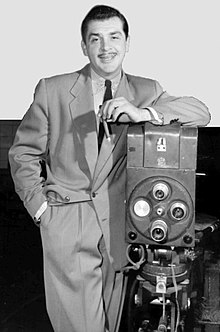| Ernie Kovacs | |
|---|---|
 Kovacs on the set of his television show in 1956 | |
| Birth name | Ernest Edward Kovacs |
| Born | January 23, 1919 Trenton, New Jersey, U.S. |
| Died | January 13, 1962 (aged 42) Los Angeles, California, U.S. |
| Resting place | Forest Lawn Memorial Park, Hollywood Hills |
| Medium |
|
| Years active | 1941–1962 |
| Genres | |
| Spouse | |
| Children | 3 |
| Relative(s) | Bill Lancaster (son-in-law) |
Ernest Edward Kovacs (January 23, 1919 – January 13, 1962) was an American comedian, actor, and writer.
Kovacs's visually experimental and often spontaneous comedic style influenced numerous television comedy programs for years after his death. Kovacs has been credited as an influence by many individuals and shows, including Johnny Carson, Rowan and Martin's Laugh-In, Saturday Night Live, Monty Python's Flying Circus, Jim Henson, Max Headroom,[1] Chevy Chase,[2][3] Conan O'Brien,[4] Jimmy Kimmel, Captain Kangaroo, Sesame Street, The Electric Company, Pee-wee's Playhouse, The Muppet Show, Dave Garroway,[5] Andy Kaufman, You Can't Do That on Television, Mystery Science Theater 3000, and Uncle Floyd, among others.[6][7] Chase even thanked Kovacs during his acceptance speech for his Emmy Award for Saturday Night Live.[8][2]
While Kovacs and his wife Edie Adams received Emmy nominations for Best Performances in a Comedy Series during 1957, his talent was not recognized formally until after his death.[9] The 1962 Emmy for Outstanding Electronic Camera Work and the Directors' Guild award came a short time after his fatal accident.[10][11] A quarter century later, he was inducted into the Academy of Television Arts & Sciences Hall of Fame.[12] Kovacs also has a star on the Hollywood Walk of Fame for his work in television.[13] In 1986, the Museum of Broadcasting (later to become the Museum of Television & Radio and now the Paley Center for Media) presented an exhibit of Kovacs's work, called The Vision of Ernie Kovacs. The Pulitzer Prize–winning television critic, William A. Henry III, wrote for the museum's booklet: "Kovacs was more than another wide-eyed, self-ingratiating clown. He was television's first significant video artist."[14]
- ^ O'Connor, John J. (March 8, 1987). "TV View: Ernie Kovacs: A comic to the medium born". The New York Times. Archived from the original on March 13, 2008. Retrieved January 7, 2008.
- ^ a b Chase, Chevy (April 9, 1977). "The Unique Comedy of Ernie Kovacs". TV Guide: 39–40.
- ^ O'Connor, John J. (November 17, 1982). "TV: Why Ernie Kovacs's humor grows with time". The New York Times. Archived from the original on March 13, 2008. Retrieved January 7, 2008.
- ^ Visconage, Matt (January 23, 2012). "Conan O'Brien and the Legacy of Ernie Kovacs". Splitsider. Archived from the original on February 15, 2013. Retrieved February 5, 2013.
- ^ Willmore, Alison (May 2, 2012). "Take a Look at the Unappreciated Genius of TV Pioneer Ernie Kovacs". Indiewire. Retrieved February 5, 2013.
- ^ Walley, David G. (1987). The Ernie Kovacs Phile. New York City: Simon & Schuster, Inc. p. 202. ISBN 978-0-918282-06-4.
- ^ Bren, Frank (October 31, 2011). "Ernie Kovacs: An American Secret". Bright Lights Film Journal. Cathedral City, CA. Retrieved January 19, 2017.
- ^ Hofer, Stephen F.(2006). TV Guide: the official collector's guide, Bangzoom Publishers.
- ^ Cite error: The named reference
CBSwas invoked but never defined (see the help page). - ^ Cite error: The named reference
Directorswas invoked but never defined (see the help page). - ^ "Emmy Awards Database-Ernie Kovacs". Academy of Television Arts & Sciences. Archived from the original on April 4, 2016. Retrieved March 23, 2016.
- ^ "Academy of Television Arts and Sciences Hall of Fame Inductees". Academy of Television Arts and Sciences. 1987. Archived from the original on December 18, 2013. Retrieved July 9, 2010.
- ^ "Hollywood Walk of Fame-Ernie Kovacs". Hollywood Walk of Fame. Archived from the original on March 3, 2016. Retrieved July 12, 2010.
- ^ Dudek, Duane (June 16, 1986), "'Vision of Ernie Kovacs' honors first video artist", Milwaukee Journal